Formatted and illustrated by Jacqueline Banerjee. [Click on the images to enlarge them, and for more information where available.]
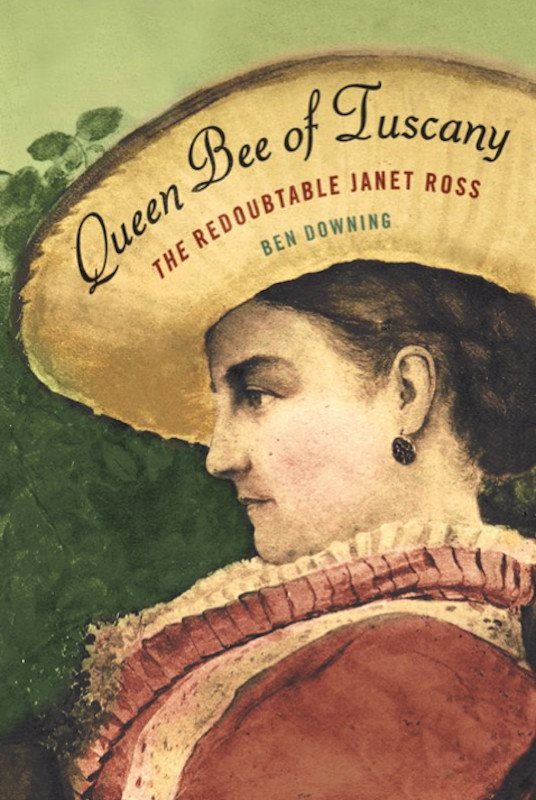
Cover of the book under review.
Ben Downing's Queen of Bee of Tuscany tells the story of Janet Duff Gordon, later Janet Ross (1842-1927), one of those generally unsung but talented and strong-minded Victorian women who deserve our attention, even admiration. Enjoyably readable, the biography further erodes the old myth of the Victorian wife as the demure and self-effacing "Angel in the House." For Janet, as the title suggests, was to become the doyenne of Florence's remarkable Anglo-American community in the later nineteenth and early twentieth centuries. But what kind of woman was she, and does Downing convince us of her claim to fame in her own right?
Wearing his extensive research lightly, Downing has unearthed details of his subject's life almost from the very beginning. Janet was the daughter of the baronet Sir Alexander Duff Gordon and Lucie, Lady Duff Gordon. Sir Alexander occupied high government positions, and his wife, the daughter of the well-known translator Sarah Austin, was herself the author of the celebrated Letters from Egypt and the translator of several foreign works. Janet grew up in a highly cultured society and met several literary figures like Thackeray, Dickens, Macaulay, Carlyle and Meredith, who had known her from childhood and was "more than a little in love" with her (qtd., 42). Several of the European writers whose works her mother had translated were also frequent visitors to the Duff Gordon house, which was located at 8 Queen's Square in Bloomsbury, London. As Janet put it herself in the memoirs of her early life, with a touch of exaggerated pride, "every foreigner of talent and renown looked upon the Duff Gordon house as a centre of interest" (32). She had a few private tutors but, like most girls of her time, did not have any formal education. She spent months in France and Germany, primarily to learn the languages.
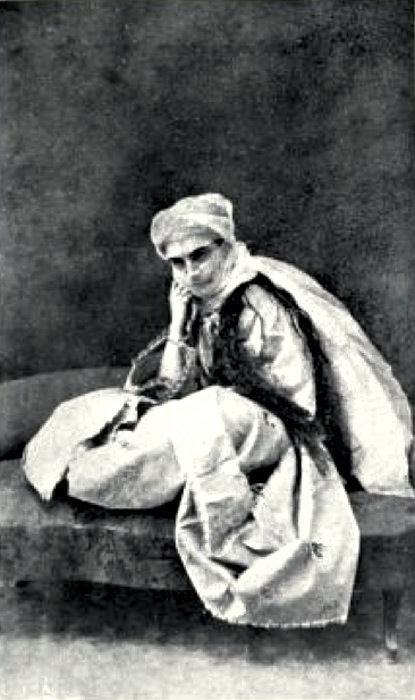
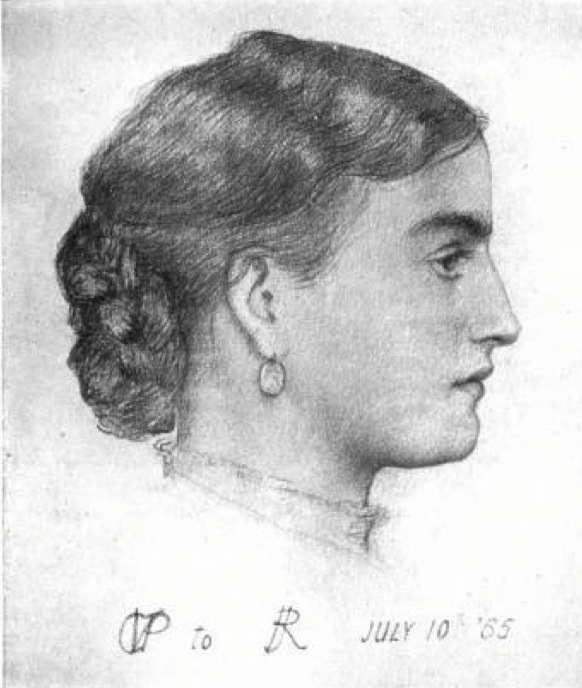
Two portraits of Janet in her book of reminiscences, The Fourth Generation. Left: In Turkish Dress, looking truly "redoubtable," facing p. 130. Right: By Valentine Prinsep, facing p. 155.
At the age of eighteen, Janet was introduced to a forty-year-old merchant-banker, Henry Ross. A keen horse-rider herself, she confessed to having been "much impressed by [Henry's] admirable riding, his pleasant conversation and his kindly ways. The result was that I promised to marry him" (46). They were married in December 1860 and went to Egypt where Henry was then working. Egypt had long been under Muslim rulers, many of whom were xenophobic. But when the reins passed in 1854 to Said, the fourth son of Muhammad Ali, Egypt turned towards the Occident. Janet had little trouble in settling in. She gradually learnt bits of Arabic, travelled around the country and made new friends, both Arabs and Europeans. One such was Ferdinand de Lesseps who was a French consul in Egypt. Janet's grandmother Sarah had known de Lesseps. He was exploring ideas of building a canal across the Isthmus of Suez, thus linking the Mediterranean and the Red Sea. Janet accompanied him in his explorations. Once they came across "a stretch of canal as yet no wider than a ditch." Janet repeatedly leapt across it, "so in years to come I can say that I have jumped the Suez Canal" (60). During the summer months when it grew infernally hot, Janet and Henry fled to England. There was another reason, caused by her pregnancy. While pregnant "she was heard to say she couldn't imagine how she had gotten that way — a joke clearly, but a pointed one" (61). Henry and Janet's married life was one of partnership with little erotic element in it. She gave birth to a son, Alexander ("Alick") Ross. Downing has little to say about him because he remained a shadowy figure in his parents' life. He was left in England with friends and family, and Henry and Janet returned to Alexandria in 1863.
At this point, the outgoing Times's Egyptian correspondent suggested to the paper's managing director Mowbray Morris that he might appoint Henry Ross in his place. The job was offered to Henry who accepted it. But the story (which has neither been denied nor proved authentically) goes that most of the Egyptian reports in the Times were in fact penned by Janet, who wrote on miscellaneous topics. Such an arrangement would not have been unique: Harriet Taylor Mill's contribution to her husband John Stuart Mill's writings also went largely unacknowledged, apparently at her own wish. Not long afterwards, Henry's business collapsed, and the couple decided to leave Egypt. Janet had earlier happened to meet her distant cousin Sir Henry Elliot, the British ambassador to Italy, who had invited her to visit Florence which was then the capital of Italy. Janet went there and was fascinated, but the Rosses first returned to England.
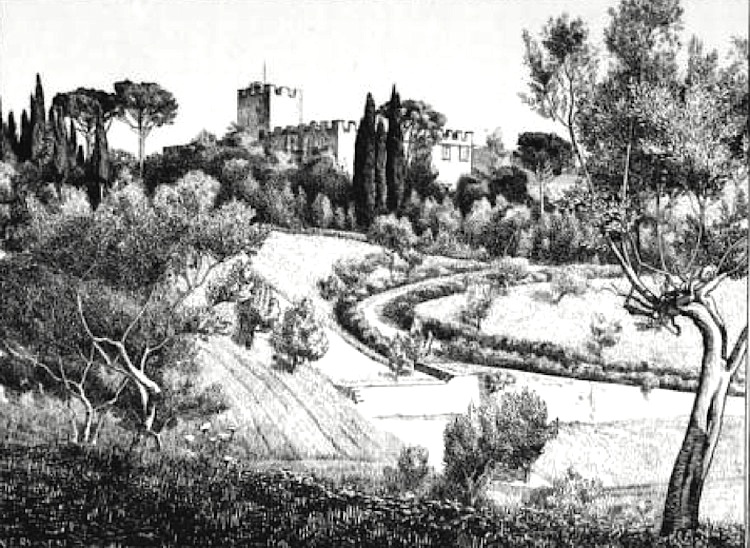
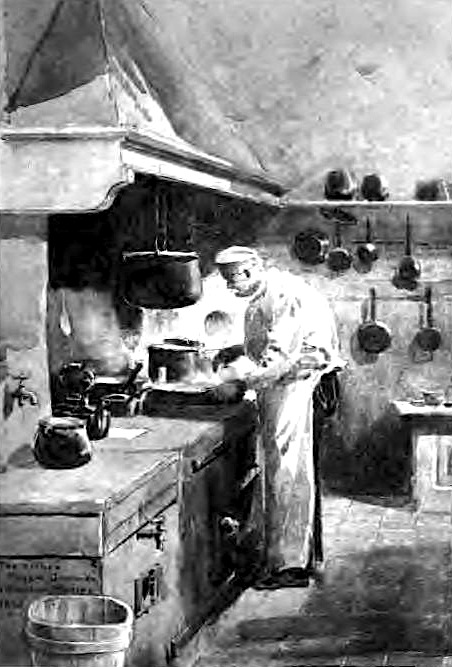
Left: Villa di Poggio Gherardo, from a drawing by Miss Nelly Erichson. Source: Ross, Old Florence, facing p. 156. Right: The Kitchen, Poggio Gherardo, by A. H. Hallam Murray. Source: Frontispiece of Ross, Leaves from Our Tuscan Kitchen.
Then came the main phase of Janet's life abroad, the much longer one to which Downing's title refers. Since the money that Henry had salvaged from the ruins of his business in Egypt was not enough to support them in comfort in their own country, the Rosses, like the Brownings before them, took their chances and went to Tuscany where life was cheaper. Remarkably, Janet was only twenty-five when they arrived in Florence in April 1867. She had no idea that she would live there for the next six decades of her life. She and her husband lived in rented accommodation for several years until they chanced to see an "old machicolated castle, with fine trees close by" (164). It was called "Poggio Gherardo" and it was for sale at a cheap price, so they bought it. It was a large property in about sixty acres, and it had an ancestry going back to the middle ages. It was believed that the building had provided the settings for Boccacio's Decameron. The Rosses moved into it in 1889. The estate was in need of extensive repairs. The new owners did not have the money to employ contractors, so, like modern expatriates, they made a project of it, and undertook the task themselves with the help of the local work-force.
Next, with equal enterprise and determination, Janet went on to cultivate the farms and became a farmer. Both the nature of the work and tenants were alien to her, but she acquired the necessary skills so that her farm yielded sufficient vegetables, fruits and grapes for both the owners and the tenants. This, Downing points out later, was quite unlike the more "scripted" endeavours of later arrivals: he describes her "satisfactions ... in overhauling and running Poggio Gherardo" as "organic and spontaneous" (288). The Rosses settled in Florence as a key part of what was a sizeable Anglo-American Tuscan community, and the way of life that they developed for themselves became the regular routine for years to come.

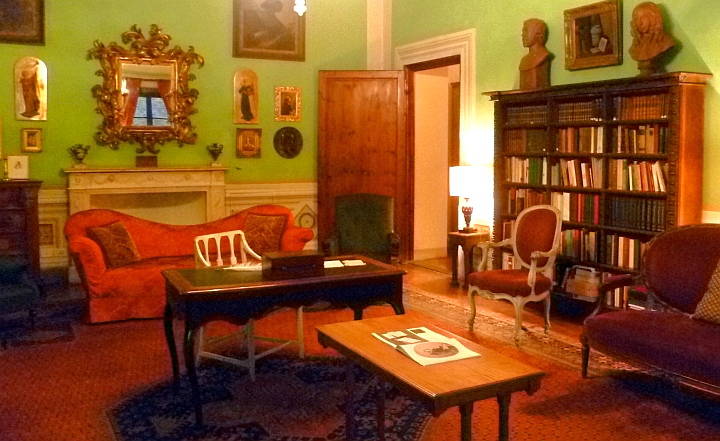
Left: The Ponte Vecchio over the Arno, in Florence. Right: Drawing-room of the Casa Guidi, where the Brownings had lived in Florence.
Early in his account of this part of their lives, Downing digresses usefully, to give a detailed history of the expatriate community in Florence. He starts with the history of Tuscany itself which originated with the Etruscans, and guesses that the first English writer to visit Tuscany was "Geoffrey Chaucer [who] quite possibly went there: Chaucer visited Italy in 1372-73, primarily on a mission to Genoa, and he may also have swung by Florence" (80). Visits by Hobbes and Milton are easier to authenticate, and by the eighteenth-century Florence had acquired an aura of its own in England. Dr Johnson is reputed to have said, "a man who has not been to Italy is always conscious of an inferiority" (qtd., 82). Subsequently, especially in the nineteenth-century, a very large number of English writers, beginning with Keats and Shelley, down to the Brownings, made Italy their home at one time or another. Quite a few important figures from other walks of life, like the scientist Mary Somerville, and art critics, painters (John Singer Sargent was born here in 1856), and art-dealers, were also drawn here. Sculptors came too, indeed, in an area close to the Carrara marble quarries, "it was the sculptors who truly thrived" (93). Thus Horatio Greenough and Hiram Powers were among the several Americans who entered the scene, along with Harriet Beecher Stowe and Nathaniel Hawthorne, who enjoyed a four-month stay in Florence with his family in 1858. Downing admits that "[T]he loss of the Brownings marked the beginning of the end of the heroic age of the colony" (111), and that subsequently it was "somewhat deficient in literary talent" (230), but when the Rosses arrived it still hummed with literary and artistic life, and his contention is that Poggio Gherardo to some extent took over from the Brownings' Casa Guidi as the hub of this highly cultured community:
While it would be hyperbolic and inaccurate to call Poggio Gherardo the new Casa Guidi, over time it acquired a similar cachet. A Sunday jaunt to the castle became almost obligatory, part of the prescribed itinerary of the fin de siècle British visitor to Florence. [192].
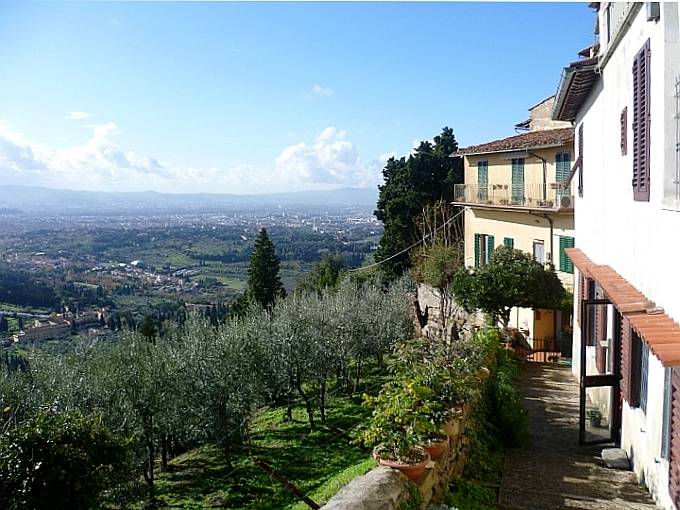

Left: The view from Fiesole. Right: The ark-shaped tomb of William Holman Hunt's wife, Fanny, which Hunt was working on when Janet knew him.
To occupy this position, even now, was no mean feat. A "favourite companion" in late 1868 was the Pre-Raphaelite artist William Holman Hunt, who had returned to Florence after his wife Fanny's death there in 1866: she "often kept [him] company in his Fiesole studio" (123) where he was designing her tomb and working up a study of Egyptian pigeons, which made her feel nostalgic for her own past. Among the Sunday visitors whom Janet was to provide with company, food, drink and conversation were the popular British novelist Marie Corelli, the British poet laureate Alfred Austin and, making a poignant link with the recent past, the Brownings' son Penn.
One outstanding American author who entered Janet's life here was Mark Twain. Twain had visited Italy and Florence previously, but in 1891 he and his wife Livy came to Florence for a longer stay. Twain asked his friend Willard Fiske, a retired Cornell professor, for information about accommodation. Fiske took Twain to Poggio Gherardo where he met Janet, who then arranged for Twain and his wife to see Villa Viviani nearby: "Quoted a laughably low rent, they rented it on the spot, with the lease to begin in September" (194). Before the Clemenses came to live there, the energetic and helpful Janet had the whole house scoured and cleaned, and curtains washed. Twain was delighted when he returned. In his autobiography Twain said that "life at a Florentine villa [was] an ideal existence" (qtd., 194). Unlike most of the Rosses' visitors, Twain "had no interest in Italian society, and very little in the artistic treasures of Florence, as of Europe in general" (196), but he seems to have entered into the spirit of things all the same. One day, for instance, he suddenly surprised everybody by shaving his head. He announced he did so in the hope that like the natives he would be able to master the (to him) incomprenensible language. He had noticed that "their heads were all as smooth as billiard balls. Perchance his heavy crop prevented the tongue from filtering through" (195). In any case, Twain proved productive as a writer during his stay in Tuscany. He wrote much of Pudd'nhead Wilson, Tom Sawyer Abroad, and some of Personal Recollections of Joan of Arc there. His months in Florence, says Downing, "had been his happiest for a long time," and being close to Poggio Gherardo, "and the welcome he and his daughters found there ... made a difference to him" (196). Impressed by Janet's "farm," he told her about American sweet corn, and promised to send her seeds of corn as well as water-melon when he returned. "Soon afterward the seeds themselves arrived. Janet says nothing about the fate of the corn and is dismissive of the watermelon, which she found 'not nearly as good' as similar Italian melons" (196).
Poggio Gherardo was for the most part a happy home, gathering more and more people to it. Downing fills in another corner of Janet's life by introducing her niece Lina, the daughter of her brother Maurice Duff Gordon, and his wife Fanny Ball Hughes. Maurice had fallen in love with another woman, Sophie Marie Steer, and "turned his back on his wife and daughter" (177). Janet was fond of Lina, whom she had known from childhood, and when the girl's situation worsened, she and Henry brought her to Poggio Gherardo and adopted her. It was an excellent arrangement for all concerned. According to Downing, "Lina and the Rosses for the most part got along superbly, and nothing short of mutual love arose between them; they became a family not only on paper but in fact" (180). Then, when Florence was hit by earthquake in May 1895, and Poggio Gherardo suffered heavily, Janet's circle was again enlarged. In order to pay the cost of the repairs, she and Henry decided to sell their painting of Alesso Baldovenetti's Madonna and Child. They turned to the writer Charles Dudley Warner who suggested that they consult his friend, the art-historian Bernard Berenson. Berenson duly certified the painting as Baldovenetti's, enabling them to sell it at a handsome price. Thus Berenson entered the life of the Rosses. Berenson's partner Mary was also an art-historian. Previously married, she had little contact with her daughters who lived in London, and came to look upon Lina as a kind of surrogate daughter too. Once Mary's first husband had died, and she and Bernard were free to marry, these "two dynamic Americans" (200) took a sixteenth-century villa called "I Tatti" just downhill from Poggio Gherardo.
But life at the Rosses' castle was about to be shattered by what Downing calls the "long traumatic melodrama" of Lina's relationship with an Oxford graduate, Aubrey Waterfield (202). Aubrey, who had attended the Slade School of Art and wanted to be a painter, at first seemed reluctant to further the relationship, so Lina settled down with her uncle and aunt again. It was at this time that Janet took over from her a project that had been faltering: a book about Italian cooking. Within months, she had produced the most popular of her several works: Leaves from our Tuscan Kitchen or, How to Cook Vegetables (1899). Along with Dorothy Daly's Italian Cooking, this "seems to have been the first Italian cookbook in English" (207), and is probably what Janet is best known for today. Not long afterwards, however, in the spring of 1901, Aubrey resurfaced in Florence and told Lina that he had previously felt unable to support her. Now that his father had died, leaving him a small inheritance, he was ready to marry her. Janet disliked him, and was dismayed when the couple were married in July 1902. In a letter to a friend, Janet inveighed, "W. is no more worthy of Lina than yr. cat wd be" (209). Sadly, after marrying Aubrey, Lina remained estranged from her aunt for some time.
Not long afterwards came another and even more severe blow. Henry died, leaving her devastated. She wrote in her memoirs, "On July 19 my husband died, and the loss of the dear friend and companion of forty-two years left me more utterly lonely than I can say" (214). This was not the end of Janet's story, or of her importance in the expatriate community in Florence. She lived for more than twenty-five years after her husband's death, and remained a commanding figure in Poggio Gherardo. She also won some acclaim by publishing a number of new books, such as Florentine Villas (1901), Florentine Palaces and Their Stories (1905), and family memoirs. Reviewing her The Fourth Generation (1912), the New York Tribune gushed "A new candidate for immortality has presented herself. She is a woman who has lived every minute of her life.... She lived in a brilliant world among brilliant people of whom she herself was surely one of the most brilliant" (qtd., 241). But she was becoming more eccentric, and notably difficult to deal with. According to Downing, she was "always rude, ... becoming more so as she aged" (225). Age also brought her ill-health and she succumbed to cancer and died on 23 August 1927. Everyone was surprised when her will was read. She had left Poggio Gherardo to "John Waterfield [Lina's son], with a life interest for Lina" (271). Her own son Alick contested the will, but lost. He had, admits Downing, been treated shamefully. After that he again disappeared from the scene. Lina was reassured that the house would pass on to her family.
As a coda to Janet's story, at least two important English writers were later to visit to Poggio Gherardo, however fleetingly. One was the young Virginia Stephens (who would achieve fame as Virginia Woolf). Virginia was rather cutting about Janet, but granted that "she has led a bold life" and that "there can never be question of her spirit" (qtd., 228n.). The other was D. H. Lawrence. He had been introduced to Aubrey and Lina Waterfield in 1914. But it was only in 1928 that they met again when the Lawrences visited Poggio Gherardo, which had by now been passed on to them. In her book, Castle in Italy, Lina recalled this visit: "we were in at Poggio Gherardo after the death of my mother. They [Lawrence and Frieda] came to lunch with an old friend of ours, Sybil Colefax. Lawrence was looking far more ill than we had ever seen him, and he had lost much of his former vitality and sparkle" (qtd. in Lawrence, 371n.3).
Lina lived to be ninety. In old age, on reflecting her life with Janet, she tried to reach a spiritual compromise with her dead aunt:
My greatest regret is to have been tongue-tied at crucial moments when a few words would have cleared away much unhappiness. Aunt Janet was also loath to show her real feelings and I realised too late how much she loved me. She, too, never knew my feelings of love and admiration for her. A wall seemed to separate us at times and there was even a streak of Scottish dourness in both of us. [279]
Downing's biography allows those of us who might not have heard of Janet Ross before, or might not know much about her, to respond to and admire her too. He brings out her strengths, and also her complexity: if she was cantankerous, and unfair even to those as close to her as Alick and Lina, she was also "essentially large-hearted" (267). Nothing proves this better than her remarkable "ability to find common ground with so many people despite her somewhat choleric and contrary nature" (269). Her relationships with these people were generally warm, and they were drawn to her rather than put off by her decided ("redoubtable") personality. In the end, however, the most appealing aspect of the book, for this reader at least, is the light it throws on those who revolved around her — in other words, those whom the "queen bee" helped and brought together. This cannot have been Downing's main aim as a biographer, but it has produced an entertaining as well as thoroughly researched study, which succeeds in bringing an extraordinary community to life from a new perspective.
Related Material
References
The book under review: Downing, Ben. Queen Bee of Tuscany: The Redoubtable Janet Ross. New York: Farrar, Straus and Giroux, 2013. 338pp. $28.00 / £32.00. ISBN: 978-0-374-23971-8.
Lawrence, D. H. The Letters of D H Lawrence. Volume VI (1927-28). Ed. James T Boulton, Margaret Boulton with Gerald M. Lacy. Cambridge: Cambridge University Press, 1991.
Ross, Janet A. The Fourth Generation: Reminiscences. London: Dent, 1912. Internet Archive. Web. 21 April 2014.
_____. Leaves from Our Tuscan Kitchen, or How to Cook Vegetables. London: Dent, 1900. Internet Archive. Web. 21 April 2014.
_____. Old Florence and Modern Tuscany. London: Dent, 1904. Internet Archive. Web. 21 April 2014.
Last modified 21 April 2014